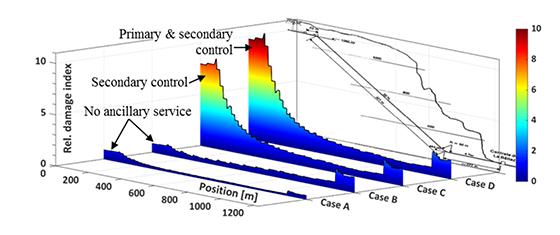A digital clone monitors penstock ageing
The electrical market prices fluctuations are driving the ageing rate of hydropower infrastructures. Starts and stops, as well as pressure oscillations, mechanically stress the penstocks and pipelines. In contrast to valves or turbines, penstocks are very difficult and costly to refurbish or replace. Therefore, hydropower infrastructure operators seek to optimize the maintenance to extend the operation life and safety of their infrastructure. In this work, scientists from the HES-SO show how the use of a numerical clone helps to achieve this by assessing the degradation of the penstocks and other components.
In the context of electrical prices volatility, the maintenance strategy takes a significant role in hydropower asset management. It should be optimized to ensure the penstock safety and the total power production over the full operation period. Today, primary and secondary control increase even the amount of mechanical solicitation on the steel linings of pressure vessels. In this work, scientists from the HES-SO evaluate the fatigue damage accumulation of penstocks. They use a numerical clone (called Hyro-clone©, developed by Power Vision Engineering) of the la Bâtiaz penstock of Energie Electrique d’Emosson where they have installed it.
Hydro-clone© is an innovative Real-Time Simulation Monitoring System comprising a soundly calibrated and validated numerical copy of the hydropower plant and is able to reproduce in real-time any dynamic behaviour of the plant’s installations based on boundary conditions measured in situ. This system continuously diagnoses the health of the hydropower plant by numerical cloning, its major hydraulic and electrical components [1]. The Hydro-clone system has been implemented and tested since 2014 at the 200 MW La Bâtiaz power plant and has been operating continuously for five years [2].

Comparison of the relative accumulated damage index along the penstock for 24h of operation under different modes from [2].
Ancillary services greatly affect penstock ageing
In this work, scientists from HES-SO compared the pressure oscillation simulated by Hydro-Clone with stress measurements at the top and the bottom of the penstocks. These results show the very good correlations between the pressure oscillation and the stress in the steel lining. It also proves that the clone is capable of creating reliable data even where there is no physical measurement.
Figure 1 clearly highlights the considerable impact of ancillary services provision on penstock fatigue solicitation. In fact, the supply of primary and secondary control leads to a damage index about 10 times greater than without ancillary service. In terms of service life, this results in penstock fatigue wear 10 times faster when these services are active. For the asset manager, it can correspond to an increase up to ten times of the maintenance costs.
The maximal damage index is obtained for the case with both primary and secondary control services. In order to isolate the impact of each service on the fatigue, the processing of a day with only primary control service would be needed. The profile of the damage index shows that the upper part of the penstock, where the stress to pressure ratio is most important, is the most prone to fatigue.
Find the best operating point with Hydro-Clone
Hydro-Clone can also simulate the behaviour of the hydropower plant according to some scenario and find the best operating point (a combination of turbine parameters) in order to reduce the index of fatigue damage of certain operation. It is also possible to compare the data acquired by the supervisory control and data acquisition (SCADA) system before the installation of Hydro-Clone. Therefore, it will be possible to recognize some relevant patterns in the past SCADA signals and to use them to evaluate the remaining lifetime of the penstock better.
Future goal: monitor crack growth speed with Hydro-Clone
In the future, the numerical clone will also be utilized in combination with an in-situ crack propagation sensor. This will permit to monitor the crack growth speed according to the pressure oscillations and thus to operate cracked pressure vessel safely until the reparation becomes needed.
Blog Article
This article will soon be availabe in the SCCER-SoE blog in German, French and English with more detailed biographies of the authors.
Acknowledgements
The present study was performed within the framework of the CTI project n° 28112.1 PFIW-IW "Penstock Fatigue Monitoring". The authors would like to thank Innosuisse - the Swiss Innovation Agency – as well as the SCCER-SoE for their financial support in this work.
References
- C. Nicolet, M. Dreyer, A. Beguin, E. Bollaert, S. Torrent, J.-D. Dayer, «Hydraulic Transient Survey at Cleuson Dixence with Real-Time Hydro-Clone Monitoring System», Proc. of Hydro 2018 Conference, Gdansk, Poland, 2018.
- M. Dreyer, C. Nicolet, A. Gaspoz, D. Biner, S. ReyMermet, C. Saillen, B. Boulicaut, «Digital clone for penstock fatigue monitoring», Proc. 8th IAHR International Meeting of the Workgroup on Cavitation and Dynamic Problems in Hydraulic Machinery and Systems, Stuttgart, Germany, 2019.
